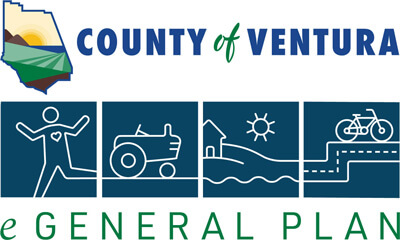The Ventura County 2040 General Plan is a long-range plan that guides decision-making, establishes rules and standards for development and county improvements, and helps to inform residents, developers, and decision-makers. It reflects the County’s vision for the future, provides direction through the year 2040 on growth and development, and is an expression of the quality of life in Ventura County.
California law requires that every county and city adopt a general plan “for the physical development of the county or city, and of any land outside its boundaries which in the planning agency’s judgment bears relation to its planning.” (Gov. Code, § 65300.) A general plan serves as the jurisdiction’s “constitution” or “blueprint” for future decisions concerning a variety of issues including land use, health and safety, and resource conservation. All area plans, specific plans, subdivisions, public works projects, and zoning decisions must be consistent with the direction provided in the County’s General Plan.
The Ventura County 2040 General Plan serves several purposes:
- Provides the public opportunities for meaningful participation in the planning and decision-making process;
- Provides a description of current conditions within the county and trends influencing the future of the county;
- Identifies planning issues, opportunities, and challenges that should be addressed in the 2040 General Plan;
- Explores land use and policy alternatives;
- Ensures that the General Plan is current, internally consistent, and easy to use;
- Provides guidance in the planning and evaluation of future land and resource decisions; and
- Provides a vision and framework for the future growth of the County of Ventura.
Ventura County is unique in California due to the successful past efforts that have guided, and continue to guide, land use planning in the county. These include the following:
- The County of Ventura, cities within the county, and the Ventura Local Agency Formation Commission (LAFCo) adopted the Guidelines for Orderly Development in 1969 to direct urban-level development and services to the incorporated areas.
- Greenbelts, voluntary agreements between the County and one or more cities, are used to limit development of agricultural and/or open space areas within the unincorporated county. Through greenbelt agreements, cities commit to not annex any property within a greenbelt while the County agrees to restrict development to uses consistent with existing agricultural or open space zoning. There are seven greenbelts in Ventura County totaling approximately 164,000 acres.
- Save Open Space & Agricultural Resources (SOAR) refers to a series of voter initiative measures that have been approved by eight of the ten cities and the unincorporated area (Ojai and Port Hueneme have not adopted SOAR measures). SOAR measures within cities establish voter-controlled urban growth boundaries, known as City Urban Restriction Boundaries (CURBs). A city’s annexation or approval of urban development of land outside of a CURB boundary requires voter approval. The County’s SOAR measure, which is included as Appendix C and incorporated by reference into the General Plan, generally requires voter approval to re-designate land with Open Space, Agricultural, or Rural General Plan land use designations, and to amend the goals and policies for these land use designations.
Using the General Plan
The General Plan is used by the Board of Supervisors, Planning Commission, and County staff to make decisions with direct or indirect land use and resource management implications. It also provides a framework for inter-jurisdictional coordination of planning efforts among officials and staff of the County and other government agencies (e.g., federal, state, regional, and local). County residents, property owners, and businesses also use the General Plan for guidance for particular geographic areas or for particular subjects of interest to them.
The General Plan is the basis for a variety of regulatory measures and administrative procedures. California planning law requires consistency between the general plan and its implementing programs, such as zoning and subdivision ordinances, capital improvement programs, area plans, specific plans, environmental review procedures and building and housing codes.
Over time the county’s population will change, its goals will evolve, and the physical environment in which its residents live and work will be altered. In order for the General Plan to be a useful document, it must be monitored and periodically revised to respond to and reflect changing conditions and needs.
The General Plan should be reviewed annually to evaluate the progress in achieving its goals. A more comprehensive and thorough review should be done every five to 10 years to assess whether the plan needs to be refined or updated to reflect changes in local conditions, local priorities, or state law. State law permits the General Plan to be amended up to four times in any calendar year, unless special conditions apply as defined by Government Code sections 65358(c) and (d). Each amendment may contain more than one change to the General Plan.
Administrative Provisions
General Plan Amendments: The County shall require that all privately initiated General Plan Amendments are screened by the Board of Supervisors to determine if the amendment is appropriate for further processing.
Interpretations: Although every effort has been made to provide goals, policies and programs that are clear, the necessity of interpreting such goals, policies and programs in light of specific and unusual cases will occur from time to time. When interpretation of General Plan goals, policies or programs is required, the Planning Director is responsible for the review and interpretation with the right of appeal by an applicant to the Planning Commission and the Board of Supervisors.
